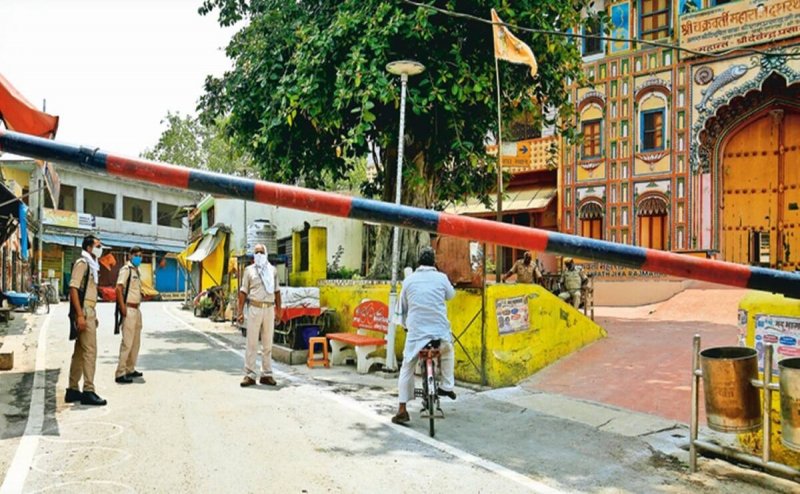

Lucknow: They are glaring at each other, refusing to relent. Rameshwar Kumar, 48, has to head back to Lucknow for work. And all his life, he has bowed his head before Hanuman Garhi, or the Ram Janmabhoomi, before leaving his hometown. On the other side, Constable Devraj Singh has the unenviable task of stopping Kumar.
Lucknow: They are glaring at each other, refusing to relent. Rameshwar Kumar, 48, has to head back to Lucknow for work. And all his life, he has bowed his head before Hanuman Garhi, or the Ram Janmabhoomi, before leaving his hometown. On the other side, Constable Devraj Singh has the unenviable task of stopping Kumar.
“I cannot let you go. There is a government order. This is a pandemic,” says Singh. As Kumar finally turns away, Singh exclaims: “What a time this is. Even faith is affected.” In the lanes of Ayodhya, there is an eerie silence. The temple town is in lockdown — and it is showing. There are policemen manning turns and entry points every few metres, shops are boarded up, and there are no crowds near vegetable carts. At the gate of the Ram Mandir, the only human presence is of a group of policemen. On the steps of the Hanuman Garhi, there are no devotees. Only seven policemen, two priests, and four sleeping monkeys.
It is a lockdown that has gained a grudging acceptance, in sharp contrast with several other smaller towns and rural districts in UP where the second wave has breached the barricades. In front of Hanuman Garhi, Sudhir Gupta is counting the losses at his famous Gayatri Mishthan Bhandar. “This is the peak season. Ram Navami would have seen lakhs of customers, and that gives us sustenance for the year. But now, seeing what has happened at Kumbh, we are glad it was locked down. It doesn’t matter where you live, everyone feels afraid. Here, the lockdown is very strict, and there are CCTV cameras everywhere too. So when there is a crowd of people, the police come immediately,” he says.
Gupta’s reference to the Kumbh is telling. At the Kumbh in Haridwar last month, several measures were in place to curb the spread, including mandatory negative tests for entry. But none of them were strictly implemented even as the crowd swelled to over 30 lakh on days of the shahi snan (royal bath). Finally, an appeal from Prime Minister Narendra Modi to the akhadas to minimise the numbers led to the last shahi snan being observed at a “symbolic” level. Haridwar district, incidentally, recorded 17,226 new cases and 90 deaths between April 1 and April 30.
Ayodhya took a different approach.
“Last month, around April 17 or so, there was the run-up to Ram Navami. It is a very big event here. More than 10 lakh people come at that time. We took all the saints, and the temples into confidence, and they came forward to say they don’t want people to throng Ayodhya. They urged all their devotees to stay home, and offer pujas at home. The major temples closed their doors, and since then the pujaris are inside and doing seva, but outsiders are not welcome. So we started preparing quite early, and that has resulted in good compliance,” says District Collector Anuj Jha.
The official numbers show a dip. On April 30, the district had 172 fresh cases and 2,393 active cases but no death. On May 12, 114 fresh cases were recorded, with four deaths and an active case load of 1,810.
During the first wave, the daily case peak was 143 on August 25, with the death toll peaking at four on September 9 and active cases at 1,154 on September 12. In the second wave, cases peaked at 357 on April 18, deaths at five on April 22, and the active caseload at 2,661 on April 27. Among the institutions shut is the Ram Janmabhoomi Teerth Kshetra Office. The office-bearers say they back the lockdown fully. “The mahants and the priests are all elderly, and Ram Navami would be tainted if people went back ill from the darshan. After what we saw in Kumbh, we were more convinced that we should comply with the district administration’s orders. It is what should have happened at Kumbh as well,” says a member of the trust, who spoke on condition of anonymity.
Back at the barricades on the main road, Constable Devraj Singh has struck up a friendship with Sudhir Gupta, who lives inside the bylanes and is one of the few allowed in. Gupta says he is thankful that very few in the immediate vicinity of Hanuman Garhi have fallen unwell. Singh responds with caution. “The mahamaari is not over yet. Here, being strict is very important. The government knows that even if the situation worsens in the rest of Uttar Pradesh, Ayodhya must come out of this without significant damage. It is far too important a place to be associated with death,” Singh says.
Your support to NYOOOZ will help us to continue create and publish news for and from smaller cities, which also need equal voice as much as citizens living in bigger cities have through mainstream media organizations.